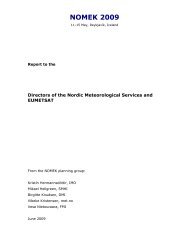International Symposium on Mitigative Measures against Snow ...
International Symposium on Mitigative Measures against Snow ...
International Symposium on Mitigative Measures against Snow ...
Create successful ePaper yourself
Turn your PDF publications into a flip-book with our unique Google optimized e-Paper software.
<str<strong>on</strong>g>Internati<strong>on</strong>al</str<strong>on</strong>g> <str<strong>on</strong>g>Symposium</str<strong>on</strong>g> <strong>on</strong> <strong>Mitigative</strong> <strong>Measures</strong> <strong>against</strong> <strong>Snow</strong> Avalanches<br />
Egilsstaðir, Iceland, March 11–14, 2008<br />
Figure 2 The design dam height H above the snow cover depth hs as a functi<strong>on</strong> of the comp<strong>on</strong>ent<br />
of the velocity normal to the dam axis, u1 sinϕ, where u1 is velocity<br />
upstream of the dam and ϕ is the deflecting angle (ϕ = 90° for catching dams), for<br />
several different values of the depth of the <strong>on</strong>coming flow h1. A momentum loss<br />
factor, k = 0.85, corresp<strong>on</strong>ding to a dam built from loose materials, is assumed in<br />
the impact with the dam. The figure shows curves derived from both supercritical<br />
overflow (red) and shock dynamics (green) labelled with the flow depth h1. The<br />
design dam height should be picked from the higher of the two curves corresp<strong>on</strong>ding<br />
to the estimated design flow depth. The part of each family of curves<br />
corresp<strong>on</strong>ding to the higher dam is drawn with solid, thick curves. The labelled<br />
axes at the top of the figures show velocity corresp<strong>on</strong>ding to the deflecting angles<br />
ϕ = 15, 25 and 35°. The dam height is measured in the directi<strong>on</strong> normal to the<br />
terrain and needs to be transformed to vertical dam height for dams <strong>on</strong> sloping<br />
terrain. (Note the logarihmic scale <strong>on</strong> the y-axis.)<br />
The dam height determined according to the new criteria is generally similar to dam height<br />
determined from traditi<strong>on</strong>al criteria. Slightly lower dams are recommended in some cases but<br />
c<strong>on</strong>siderably higher dams are required for low deflecting angles. As an example, deflecting<br />
dams with ϕ = 10−20° corresp<strong>on</strong>ding to typical Froude numbers need to be built approximately<br />
<strong>on</strong>e third higher according to the new criteria compared with the traditi<strong>on</strong>al formulae.<br />
This is, however, not as significant a change as it seems at first sight, because the run-up<br />
comp<strong>on</strong>ent of the dam height is much smaller in this case than for larger deflecting angles.<br />
The difference between the new and old criteria may, for example, lead to an increase in runup,<br />
above the snow cover from 6−8 m to 9−10 m.<br />
202 The design of avalanche protecti<strong>on</strong> dams











